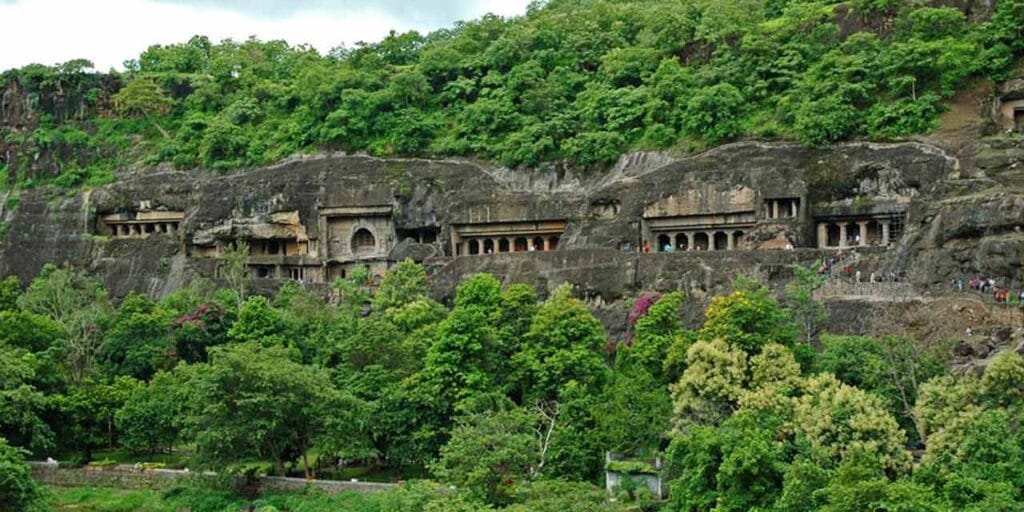Ajanta caves – nestled amidst the rugged Sahyadri hills of Maharashtra – are an extraordinary testament to India’s ancient artistry. Nowhere else in the world will you find a sublime fusion of art, religion, and history, and a UNESCO World Heritage-listed cave all in one, which explains why these caves attract travelers from all over the globe. From the intricate frescoes to the awe-inspiring rock-cut sculptures, Ajanta Caves will take you on a journey back in time, offering an unparalleled glimpse into the lives and beliefs of ancient India.
If you are planning a visit to Ajanta Caves, look no further. Read on to know more.
But before we begin, request you to please check out the link for hotels & flights to Aurangabad (Sambhaji Nagar). You will get exclusive deals with absolutely zero additional cost to you and I will be able to keep this site up & running.
Location and Geographical Context
Ajanta Caves are located in the Sambhaji Nagar (previously called) Aurangabad district of Maharashtra, about 100 km northeast of Aurangabad city and 60 km from Jalgaon. The caves are perched in a horseshoe-shaped rock face overlooking the Waghur River, which adds to their natural charm – a formation deliberately carved by the ancients to ensure sunlight would enter the caves for long periods of time. The surrounding lush greenery and the gentle flow of the river create make these caves all the more mesmerizing.
How to Reach Ajanta Caves
Let me break this in 2 parts. One is to get to Ajanta and second to reach the Caves from Parking.
Getting to Ajanta is relatively straightforward, with multiple transportation options available:
By Air
The nearest airport is Aurangabad Airport, approximately 100 km away. This airport is well-connected to major cities like Mumbai, Delhi, and Hyderabad. You will need to take a cab from the airport.
By Train
Jalgaon Railway Station (60 km away) and Aurangabad Railway Station (100 km away) are the closest railheads. From these stations, you can hire a taxi or take a bus to reach the caves.

By Road
Ajanta is well-connected by road. State transport buses and private taxis are readily available from Aurangabad and Jalgaon. For those of you driving down from Mumbai, it’s a 400 km journey through scenic highway.
State Transport Buses: This is the most economical option and connect Ajanta with Jalgaon, Aurangabad, and other nearby towns.
Private Taxis: Widely available and offer greater flexibility for travelers. Costs may range from ₹2,000 to ₹3,500 for a round trip from Aurangabad.
From Parking to Caves
The caves are situated about 4 km from the main parking area. To preserve the site and its environment, private vehicles are not allowed beyond the parking zone. However, there are eco-friendly shuttle buses provided by the Archaeological Survey of India (ASI) and the Maharashtra Tourism Development Corporation (MTDC).
- Shuttle Service Details:
- Fare: ₹20–₹30 per person (round trip).
- Frequency: Every 10–15 minutes.
- Travel Time: Approximately 10 minutes.
History of Ajanta Caves
The history of Ajanta Caves dates back to the 2nd century BCE (yes, its that ancient!), making this one of the oldest surviving examples of Indian rock-cut architecture. The caves were carved out in two phases:
- The Hinayana Phase (2nd century BCE to 1st century CE): During this period, simpler structures with stupas and monasteries were created. The focus in this period was on the worship of Buddha in symbolic forms.
- The Mahayana Phase (5th century CE): This phase saw the creation of more elaborate caves with intricate sculptures and frescoes. The Mahayana sect of Buddhism introduced the depiction of Buddha in human form.
The caves served as a monastic retreat for Buddhist monks and a site for religious and educational activities. The caves were gradually abandoned after the decline of Buddhism in India but were rediscovered in 1819 by a British officer named John Smith during a hunting expedition.
Architecture and Artistic Brilliance
Ajanta Caves are a marvel of rock-cut architecture and artistry. There are 30 caves, including both chaityas (prayer halls) and viharas (monastic halls). These caves were meticulously carved into the basalt rock using primitive tools, which shows how incredible the craftsmanship of ancient artisans.

Paintings and Frescoes
One of the most striking features of Ajanta is its murals. These paintings, created using natural pigments, depict scenes from the Jataka tales, illustrating the previous lives of Buddha. The colors, derived from minerals and plants, have stood the test of time, retaining their vibrancy. Common themes include compassion, love, and the victory of good over evil.
Sculptures
The sculptures at Ajanta are equally impressive. From the serene images of Buddha in meditative postures to intricate carvings of bodhisattvas and celestial beings, the caves are a treasure trove of artistic excellence. Highlights include:
- The reclining Buddha in Cave 26, depicting his Mahaparinirvana (ultimate liberation).
- The ornate bodhisattva Padmapani in Cave 1.
Architectural Layout
Each cave is unique, with varying sizes and styles. The chaityas have vaulted ceilings with wooden ribs carved into stone, while the viharas are rectangular halls with cells for monks. The symmetry, precision, and harmony of these structures are truly remarkable.
Entry Fees and Timings of Ajanta Caves
To ensure the preservation of this heritage site, entry is regulated. Here are the details:
- Entry Fee:
- ₹40 for Indian citizens.
- ₹600 for foreign nationals.
- Children below 15 years: Free entry.
- Timings:
- The caves are open from 9:00 AM to 5:30 PM, closed on Mondays. Please ensure you arrive well in time as exploring the caves can take anything between 3 to 4 hours and can be exhausting.
- Tickets can be purchased online or at the site.
The exhausting effort of climbing steps, walking around the caves can leave one feeling terribly hungry. So next up are some food options.
Food Options/ Hotels near Ajanta Caves

While there are no dining options directly near the cave premises, several eateries are located near the parking area. These offer a range of local and multi-cuisine meals. Be sure to eat here as you will not be able to carry food inside the caves.
- Ajanta T Junction Restaurant: Known for its simple, vegetarian Indian meals.
- MTDC Ajanta Restaurant: Operated by the Maharashtra Tourism Development Corporation, this is a reliable spot offering North Indian, South Indian, and Maharashtrian dishes.
- Local Food Stalls: Small stalls and vendors near the parking area sell snacks like vada pav, samosas, tea, and coffee.
- Guavas: Aurangabad is known for the best variety of guavas, you can always help yourself to these tasty fruits.
Washroom Facilities at Ajanta Caves
To cater to the large number of visitors, modern washroom facilities have been installed in the Ajanta Caves complex. But during times of excessive crowd, these facilities are not adequate. Here’s what you can expect:
- Location: Washrooms are located near the parking area and the entrance to the caves.
- Cleanliness: Maintained regularly by ASI and MTDC staff, but cleanliness can vary depending on the crowd.
- Fees: Some facilities may charge a nominal fee (₹5–₹10) for maintenance.
- Accessibility: Separate washrooms are available for men and women, but wheelchair-accessible toilets are limited.
Few Tips/Suggestions if You plan to visit
- Carry tissues, hand sanitizers, and wet wipes for added hygiene.
- Use washrooms at the visitor center or parking area before starting your exploration of the caves, as there are no facilities inside the caves themselves.
- Best Time to Visit: The ideal time to visit is between October and March when the weather is pleasant. The monsoon season (June to September) is also a good option, as the surrounding greenery enhances the beauty of the area. Avoid weekends & festival holidays, the rush is maximum during such times.
- Footwear: Comfortable shoes are a must, as exploring the caves involves walking and climbing stairs.
- Hydration: Carry water bottles, especially in the summer months, as the area can get warm.
- Guide Services: Hiring a local guide can enrich your visit by providing deeper insights into the history and significance of the caves.
- Food Restrictions – If you have dietary restrictions, consider packing your own meals, as choices may be limited in the area
Accolades won by the Ajanta Caves
Ajanta Caves have been internationally recognized for their cultural and historical significance:
- UNESCO World Heritage Site: Listed in 1983, it is celebrated as a masterpiece of human creative genius.
- Global Tourism Awards: The site frequently features on lists of top cultural and heritage destinations in India.
Few Additional things to Do at Ajanta Caves
Ajanta Caves are more than just a historical site; they offer a holistic experience for history buffs, art enthusiasts, and spiritual seekers alike.
1. Explore the Caves
Spend time exploring the intricate carvings and vibrant murals in each cave. Don’t miss Caves 1, 2, 16, 17, and 26, which are my favorites and are also considered the finest examples of Ajanta’s art.
2. Photography
The play of natural light in the caves provides excellent opportunities for photography. While flash photography is prohibited to protect the paintings, the available light enhances the textures and hues of the frescoes.
3. Interpretative Center
Visit the Ajanta Visitor Center near the parking area. It offers replicas of the caves, multimedia exhibits, and informative displays to enhance your understanding of the site.
4. Souvenir Shopping
The handicraft stalls near the entrance sell miniature paintings, Buddha statues, and other souvenirs inspired by Ajanta’s art.
5. Enjoy the Scenic Views
The panoramic view of the caves and the Waghur River from the hilltop viewpoint is breathtaking. It’s an ideal spot for relaxation and reflection.
Conclusion
Ajanta Caves are a timeless marvel, a harmonious blend of natural beauty and human ingenuity. Visiting this iconic site is like stepping into a living museum that narrates the story of India’s artistic and spiritual evolution. Whether you’re a history enthusiast, an art lover, or simply seeking tranquility, Ajanta promises a journey that will leave you inspired and awestruck.
Pack your bags, step into the ancient world, and let the mesmerizing Ajanta Caves transport you to a bygone era of unparalleled creativity and devotion.
My Other Posts
If you are looking for options in Kashmir, check out my posts on Pahalgam, Gulmarg, Snowfall in Kashmir, and Best Time to Visit Kashmir. If you are looking for options in Ladakh, check out Ladakh Weather, Nubra Valley, 5 Days Kashmir Itinerary, Best Packing tips for Ladakh & best tourist places in Ladakh.
If you are looking for something in Sikkim, check Tsomgo Lake, Nathu La Pass, Baba Harbhajan Singh Mandir and Batasia Loop. If you are looking for some jungle safari read Gir Safari, or Bandipur Safari, feel blessed at Sri Venugopala Swamy Temple in Mysore.
If you are looking for places to visit in the Andaman Islands, please check my posts on Radhanagar Beach & Ross Island.
If you are looking for other options, check my posts on Murud Janjira, Kashid, Pirwadi Beach and Kihim Beach in Maharashtra or Malshej Ghat, Matheran Resorts, Kailash Temple Ellora, Vandri Lake, Kelwa Beach in Palghar & Mahabaleshwar.
Alternatively, if you are interested in some Religious tourism, please check my posts on Golden Temple, Kamakhya, Trimbakeshwar, Somnath Temple, Kalighat Temple, Dakshineswar Temple and Kashi Vishwanath. If you are looking for North East Adventure tours, check my posts on Shillong, Meghalaya, Dawki, Double Decker Living Root Trek, and 7-Day North East Itinerary.

